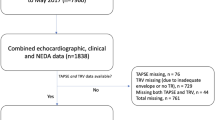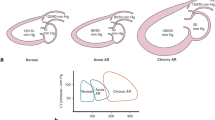Abstract
Aims
Tricuspid regurgitation (TR) in patients with mitral valve disease is associated with poor outcome and mortality. Only limited data on the impact of TR on functional outcome and survival in patients undergoing MitraClip procedures are available.
Methods and results
261 patients (mean age 76.6 ± 10, EuroScore 15.9 ± 15.1%) with symptomatic mitral regurgitation (MR) (75.2% functional MR) undergoing MitraClip procedure were included and followed for 721 ± 19.4 days. At baseline 54.7% presented with TR grade 0/I, 29.5% with grade II, 13.4% with grade III and 2.3% with grade IV. When dividing groups according to baseline TR grades, follow-up (FU)-NYHA class was significantly improved only in patients with TR ≤ II (p = 0.05). FU-6-min walking distance increased significantly in the overall cohort (p = 0.05), in patients with TR ≤ II (p = 0.007), but not in patients with TR > II (p = 0.4). Moreover, FU-NT-pro-BNP levels were higher in patients with TR > II (p = 0.05), compared to patients with TR ≤ II. There was a higher mortality according to baseline TR > II and multivariate Cox regression revealed TR > II as the strongest independent predictor for mortality (hazard ratio 2.04).
Conclusions
Concomitant TR at baseline negatively influences functional outcome and mortality in patients undergoing MitraClip procedures. Our results underline the need for dedicated interventional strategies for the treatment of TR in patients with symptomatic MR.



Similar content being viewed by others
Abbreviations
- EROA:
-
Effective regurgitant orifice area
- LV:
-
Left ventricle/ventricular
- LVEDV:
-
Left ventricular end diastolic volume
- LVEF:
-
Left ventricular ejection fraction
- MR:
-
Mitral regurgitation
- MV:
-
Mitral valve
- PISA:
-
Proximal isovelocity surface area
- RV:
-
Right ventricle
- TR:
-
Tricuspid regurgitation
References
Iung B (2003) A prospective survey of patients with valvular heart disease in Europe: the Euro Heart Survey on valvular heart disease. Eur Heart J 24:1231–1243
Vahanian A, Alfieri O, Andreotti F, Antunes MJ, Baron-Esquivias G, Baumgartner H, Borger MA, Carrel TP, De Bonis M, Evangelista A, Falk V, Iung B, Lancellotti P, Pierard L, Price S, Schofers HJ, Schuler G, Stepinska J, Swedberg K, Takkenberg J, Von Oppell UO, Windecker S, Zamorano JL, Zembala M, Bax JJ, Ceconi C, Dean V, Deaton C, Fagard R, Funck-Brentano C et al (2012) Guidelines on the management of valvular heart disease (version 2012). Eur Heart J 33:2451–2496
Boekstegers P, Hausleiter J, Baldus S, Von Bardeleben RS, Beucher H, Butter C, Franzen O, Hoffmann R, Ince H, Kuck KH, Rudolph V, Schäfer U, Schillinger W, Wunderlich N (2014) Percutaneous interventional mitral regurgitation treatment using the Mitra-Clip system. Clin Res Cardiol 103(2):85–96
Zuern CS, Bauer A, Lubos E, Boekstegers P, Puls M, Bardeleben RSV, Ouarrak T, Butter C, Eggebrecht H, Nickenig G, Zahn R, Senges J, May AE (2015) Influence of non-cardiac comorbidities on outcome after percutaneous mitral valve repair: results from the German transcatheter mitral valve interventions (TRAMI) registry. Clin Res Cardiol 104:1044–1053
Maisano F, Franzen O, Baldus S, Schofer U, Hausleiter J, Butter C, Ussia GP, Sievert H, Richardt G, Widder JD, Moccetti T, Schillinger W (2013) Percutaneous mitral valve interventions in the real world: early and 1-year results from the ACCESS-EU, A prospective, multicenter, nonrandomized post-approval study of the Mitraclip therapy in Europe. J Am Coll Cardiol 62:1052–1061
Wallenborn J, Störk S, Herrmann S, Kukuy O, Fette G, Puppe F, Gorski A, Hu K, Voelker W, Ertl G, Weidemann F (2016) Prevalence of severe mitral regurgitation eligible for edge-to-edge mitral valve repair (MitraClip). Clin Res Cardiol 105(8):699–709
Shiran A, Sagie A (2009) Tricuspid regurgitation in mitral valve disease. incidence, prognostic implications, mechanism, and management. J Am Coll Cardiol 53(5):401–408
Di Mauro M, Bivona A, Iacò AL, Contini M, Gagliardi M, Varone E, Gallina S, Calafiore AM (2009) Mitral valve surgery for functional mitral regurgitation: prognostic role of tricuspid regurgitation. Eur J Cardiothorac Surg 35:635–640
De Bonis M, Lapenna E, Sorrentino F, La Canna G, Grimaldi A, Maisano F, Torracca L, Alfieri O (2008) Evolution of tricuspid regurgitation after mitral valve repair for functional mitral regurgitation in dilated cardiomyopathy. Eur J Cardiothorac Surg 33:600–606
Sagie A, Schwammenthal E, Newell JB, Harrell L, Joziatis TB, Weyman AE, Levine RA, Palacios IF (1994) Significant tricuspid regurgitation is a marker for adverse outcome in patients undergoing percutaneous balloon mitral valvuloplasty. J Am Coll Cardiol 24:696–702
Koelling TM, Aaronson KD, Cody RJ, Bach DS, Armstrong WF (2002) Prognostic significance of mitral regurgitation and tricuspid regurgitation in patients with left ventricular systolic dysfunction. Am Heart J 144:524–529
Feldman T, Foster E, Glower DD, Kar S, Rinaldi MJ, Fail PS, Smalling RW, Siegel R, Rose GA, Engeron E, Loghin C, Trento A, Skipper ER, Fudge T, Letsou GV, Massaro JM, Mauri L (2011) Percutaneous repair or surgery for mitral regurgitation. N Engl J Med 364:1395–1406
Lancellotti P, Moura L, Pierard LA, Agricola E, Popescu BA, Tribouilloy C, Hagendorff A, Monin JL, Badano L, Zamorano JL, Sicari R, Vahanian A, Roelandt JRTC (2010) European association of echocardiography recommendations for the assessment of valvular regurgitation. Part 2: mitral and tricuspid regurgitation (native valve disease). Eur J Echocardiogr 14(7):611–644
Rodés-Cabau J, Taramasso M, O’Gara PT (2016) Diagnosis and treatment of tricuspid valve disease: current and future perspectives. Lancet (London, England). doi:10.1016/S0140-6736(16)00740-6
Nishimura RA, Otto CM, Bonow RO, Carabello BA, Erwin JP, Guyton RA, O’Gara PT, Ruiz CE, Skubas NJ, Sorajja P, Sundt TM, Thomas JD (2014) 2014 AHA/ACC guideline for the management of patients with valvular heart disease: a report of the American college of cardiology/American heart association task force on practice guidelines. J Am Coll Cardiol 148(1):e1–e132
Rogers JH, Bolling SF (2009) The tricuspid valve: current perspective and evolving management of tricuspid regurgitation. Circulation 119(20):2718–2725
Ohno Y, Attizzani GF, Capodanno D, Cannata S, Dipasqua F, Imme S, Barbanti M, Ministeri M, Caggegi A, Pistritto AM, Chiaranda M, Ronsivalle G, Giaquinta S, Farruggio S, Mangiafico S, Scandura S, Tamburino C, Capranzano P, Grasso C (2014) Association of tricuspid regurgitation with clinical and echocardiographic outcomes after percutaneous mitral valve repair with the MitraClip System: 30-day and 12-month follow-up from the GRASP Registry. Eur Hear J Cardiovasc Imaging 15:1246–1255
Siegel RJ, Biner S, Rafique AM, Rinaldi M, Lim S, Fail P, Hermiller J, Smalling R, Whitlow PL, Herrmann HC, Foster E, Feldman T, Glower D, Kar S (2011) The acute hemodynamic effects of mitraclip therapy. J Am Coll Cardiol 57:1658–1665
Rogers JH, Franzen O (2011) Percutaneous edge-to-edge MitraClip therapy in the management of mitral regurgitation. Eur Heart J 32(19):2350–2357
Schofer J, Bijuklic K, Tiburtius C, Hansen L, Groothuis A, Hahn RT (2015) First-in-human transcatheter tricuspid valve repair in a patient with severely regurgitant tricuspid valve. J Am Coll Cardiol 65:1190–1195
Malasa M, Werner N, Nickenig G, Hammerstingl C (2016) Transcatheter tricuspid valve repair in a patient with isolated functional tricuspid valve regurgitation. Eur Heart J 37:855
Hammerstingl C, Schueler R, Malasa M, Werner N, Nickenig G (2016) Transcatheter treatment of severe tricuspid regurgitation with the MitraClip system. Eur Heart J 37:849–853
Rodés-Cabau J, Hahn RT, Latib A, Laule M, Lauten A, Maisano F, Schofer J, Campelo-Parada F, Puri R, Vahanian A (2016) Transcatheter therapies for treating tricuspid regurgitation. J Am Coll Cardiol 67(15):1829–1845
Author information
Authors and Affiliations
Corresponding author
Ethics declarations
Conflict of interest
There are no conflicts of interest.
Funding
The study was not funded.
Additional information
R. Schueler and C. Öztürk contributed equally to the manuscript.
Electronic supplementary material
Below is the link to the electronic supplementary material.
Rights and permissions
About this article
Cite this article
Schueler, R., Öztürk, C., Sinning, JM. et al. Impact of baseline tricuspid regurgitation on long-term clinical outcomes and survival after interventional edge-to-edge repair for mitral regurgitation. Clin Res Cardiol 106, 350–358 (2017). https://doi.org/10.1007/s00392-016-1062-1
Received:
Accepted:
Published:
Issue Date:
DOI: https://doi.org/10.1007/s00392-016-1062-1




